Acoustics in learning spaces
In this guest post Colin Campbell discusses some case studies of acoustics in learning spaces in Germany and the Netherlands.
The relationship between sound and learning spaces is not only about decibels but about how we feel in the space – What kind of atmosphere do we want regarding classroom management and behaviour?
As an Industry Partner in the ILETC project, we at Saint-Gobain Ecophon want to share in the learning process and continue our journey to support the development of optimal learning environments from the perspective of acoustics. We are dedicated to making sure we understand how to optimise acoustic design to support an innovative learning environment. Learning spaces should provide clear speech communication, low levels of noise and in turn should reduce distraction, disturbance and stress which can be associated with a lack of control of these aspects.
So back to how the sound environment affects how we feel….
If we focus on the auditory impact of learning environments, it is surprising the profound impact acoustics can have. Numerous studies have shown how acoustic quality can affect classroom management and behavior during teaching and learning activities. Our work has involved digging deeper to identify learning spaces which work well as they can inform us better about how and why the acoustic quality can be a hidden barrier to unlocking the potential of learning spaces. The better the sound environment the more positive the students are towards participating which means teachers can also be positive and proactive. In contrast the poorer the sound environment the less engaged the students are likely to be which can create a negative atmosphere which teachers have to deal with taking time and energy away from the quality of teaching. It is also clear that a “one size fits all” approach is not practicable because it ends up not optimal for any teaching and learning activity.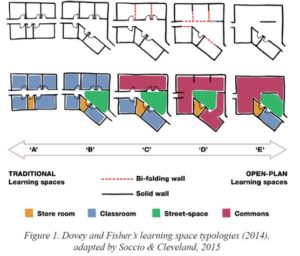
With sound foremost in our minds we have undertaken studies of some existing schools which are working successfully and represent learning spaces in the B, C & D range as we believe there is much to learn from looking into learning spaces which are in the range between fully closed and fully open.
Unlocking the spaces beyond the traditional classroom…..
The vast majority of schools which exist around the world will not be new build never mind open learning landscapes. So it is also important to find ways of potentially remodeling the existing traditional schools to inspire a positive transformation. Remodeling existing corridor spaces can be an effective first step in this transition from teaching in formal classrooms to learning in more informal and multi-purpose common street spaces (as illustrated below).
Here are some of our key findings from the three case studies which show that acoustics may be the key to encouraging the use of effective spaces….
The 1st case study is Witzenhausen School in Germany and the remodeling of a traditional Type A teaching space to create a positive teaching and learning environment. Before the design process started the teachers had stated their preference for open learning spaces to support the openness of the pedagogics. Along with the architect and acoustic advisors, they set out to create an activity based design prioritising acoustics and lighting to facilitate their aspirations for openness.
The now semi-open school has been received very well since being remodeled over 5 years ago. After visiting on many occasions and receiving positive ongoing feedback from the teachers and students about the acoustic environment, we set out to explain how the unique activity based acoustic design supports the success of the school.
The simple but well thought out acoustic design utilizes overlapping sound trap openings between class spaces (See photo below). The high performance sound absorption in the class spaces and the sound trap openings prevent the unwanted build-up of noise and reduce it spreading out over distance to the adjacent spaces. It is basically educationally open from a visual aspect whilst being acoustically closed and this contributes to its ongoing success.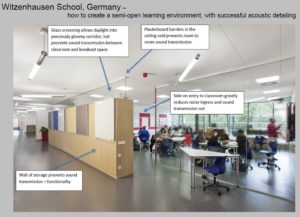
We wanted to assess the acoustic closure, the actual sound level reduction as measured from the classroom spaces, through the circulation space and through to the neighbouring classroom space.
The head teacher shared the enthusiasm of one of the teachers who experienced the students generally arriving earlier for the first class of the day. The students gathered and started to talk about relevant topics going on in the outside world. This resulted in an increase in constructive discussions from the outset, transforming the positivity and ultimately the effectiveness of the lessons.
For more info about this click here.
The 2nd case study is DeWerkplaats school in the Netherlands, an existing primary school (in pink), which is fairly traditional and has cellular classrooms with large sliding doors allowing the classes to spread out into the breakout street spaces which are used effectively and on a daily basis.
This school is quite unique and when the you consider its philosophy: “It’s not a concept but a culture” you have a feeling there is much to be learned about the school.
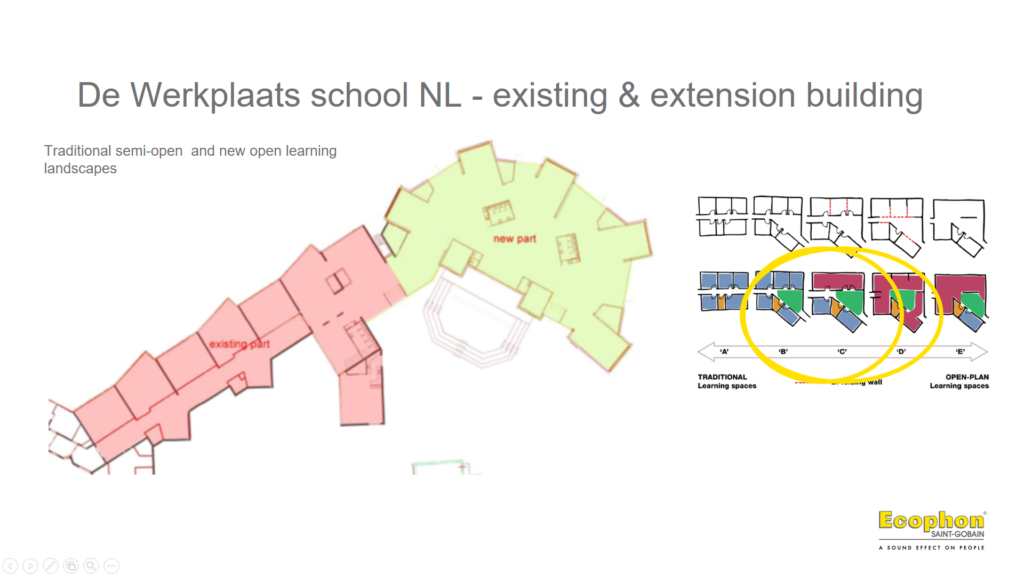
The DeWerkplaats primary school is split into an existing and has a reasonably traditional primary school (in pink 2nd case study) for 5-8 years and a more open new extension (in green 3rd case study) for 9-12 years. Typology of Space – (B/C), shown in the pink plan drawing . Typology of Space (C/D) shown in the green plan.
This can, and has in the DeWerkplaats example, transformed static formal teaching in the cellular spaces into more dynamic teaching and learning approaches by utilizing the expanded informal street spaces. So in this case study, we wanted to understand more about the sound environment between the classrooms, the street space directly outside, the adjacent street space and classroom, plus the influence of the sliding doors. The students begin lessons and have their formal teaching in their class zones before spreading into the informal street spaces. The head teacher believes these existing spaces with the sliding doors act as a great stepping stone towards more open spaces which are experienced in the next stage for older students. The students aclimatise and understand how to behave and to respect other students doing different activities in adjacent spaces.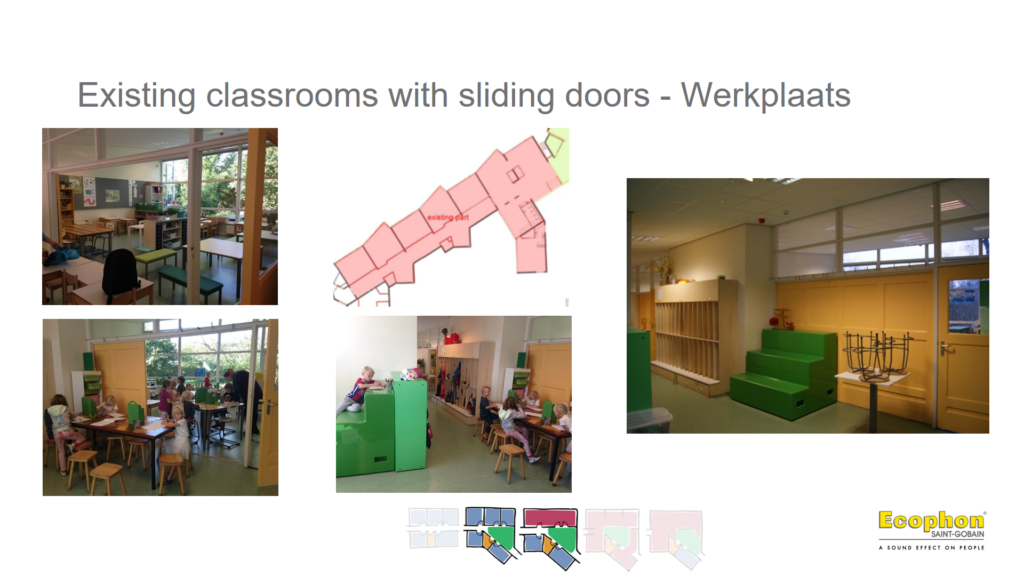
Lessons begin in the classrooms and then the sliding door can be opened up to the street space giving the students a choice in where they do their work.
The 3rd case study is the new extension (in green below) to DeWerkplaats school which focuses on the new open learning space for (9-12 yr olds), a Typology of Space (C/D) shown in the green plan.
 Above is a 180 degree view of the primary learning spaces connected with the informal learning spaces. There are few parallel wall surfaces between the class spaces which are acoustically zoned with partitions and the central utility blocks.
Above is a 180 degree view of the primary learning spaces connected with the informal learning spaces. There are few parallel wall surfaces between the class spaces which are acoustically zoned with partitions and the central utility blocks.
There is considerable acoustic treatment throughout the school; “Class A” Absorption suspended ceiling everywhere, additional 40mm high performing sound absorbing free hanging units and retro fitted wall absorption. There is also heavy usage of absorbing and partitioning furniture which helps to break up the spaces, scatter and reduce the sound energy and potential negative sound distractions.
An unexpected noise disturbance issue resolved after occupation….
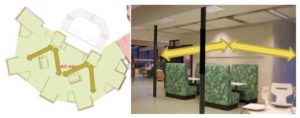
The images on the left, with the arrows, illustrate the sound reflecting off two hard and flat walls disturbed the connected spaces. The solution involved additional sound absorbing wall panels being fitted and eliminated the disturbing sound reflections (shown as yellow arrows above) between the connected spaces.
One aspect which needed to be addressed after the school was in operation was some sound disturbances from teachers. This was understood for the most part to be due to talking to their local class in standing positions which on occasion disturbed the neighbouring class. This disturbing speech is shown with the yellow arrows in the diagram above and was resolved by adding additional wall panel absorbers (above photo). This reduced the late reflections from the speech in the connected space. Interestingly, the headteacher commented that “the teachers perceived that the neighbouring teachers had lowered their voices”. The teachers were not aware of the additional panels installed.
Again, as with the 2nd case study group, the students in the 9-12 age group start their day in a circle close to the teacher in their own home class space. After formal introductions and lesson tasks they are free to spread out and choose a variety of learning spaces. The head teacher was very proud about the positive impact of these learning spaces. “The biggest impact of these spaces is the quality of collaboration between teachers.” This is important; the teachers know every student and vice –versa. They have a shared responsibility for all of the students and the overall learning spaces – and this is is why the design continues to work.
Colin Campbell is an industry investigator representing Ecophon on the ILETC Project and a Global Concept Developer for Educational Environments with Saint-Gobain Ecophon in Sweden. He studied Interior and Environmental Design at Duncan of Jordanstone College of Art and Design in Dundee, Scotland. Colin presented these case studies at ICBEN2017, Euronoise2018 and Internoise2018 acoustic conferences. colin.campbell@ecophon.se



